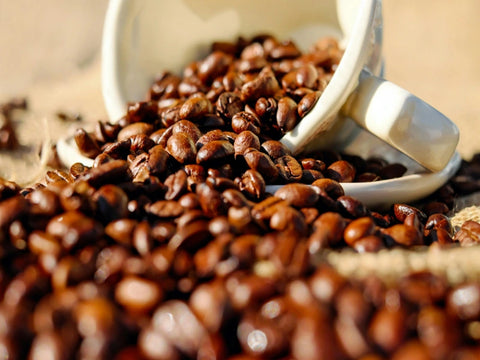If you're a coffee lover looking to explore the world of different coffee varieties and flavors, this article is for you.
We'll dive into the wonderful world of coffee, discussing the various types of coffee beans such as Arabica, Robusta, Liberica, and Excelsa.
Explore what makes coffee taste good, including the roasting process, brewing methods, and quality of beans.
Discover the tastiest coffees to drink, from single origin and specialty coffees to cold brews and espressos. Unravel the factors that affect coffee taste and learn how to enjoy the perfect cup of joe.
What Is Coffee?
Coffee is a popular beverage enjoyed by many worldwide. It is a versatile drink that can be customized to suit individual preferences, offering a unique aroma and a boost of caffeine, making it an essential part of the morning ritual for numerous people.
Throughout history, coffee has played a significant role in various cultures, with each region having its own unique take on its preparation. From the intense flavor of espresso to the smoothness of a latte, there is a coffee variety to cater to every taste. The brewing methods also vary, from the traditional pour-over technique to the convenience of single-serve pods.
People appreciate not just the stimulating effects of coffee but also the social aspect it brings, whether it's catching up with friends over a cup or savoring a quiet moment alone.
What Are The Different Types Of Coffee?

Coffee comes in various types, each distinguished by the beans used, the blend of flavors, and the roast level applied.
Arabica Coffee
Arabica coffee is one of the most popular and high-quality coffee beans known for its smooth flavor profile and varying origin locations.
Arabica beans are often praised for their complex and nuanced flavors that can range from fruity and floral notes to chocolaty and nutty undertones. The taste of Arabica coffee can be influenced by the altitude at which it is grown, with higher elevations typically producing more acidic and flavorful beans. Its reputation for quality stems from the meticulous cultivation and harvesting processes involved, resulting in a beverage that is often described as having a well-balanced acidity, mild bitterness, and a delightful aroma."
Robusta Coffee
Robusta coffee beans are known for their strong and bitter flavor profile, offering a higher caffeine content than Arabica beans.Robusta beans are often favored for their rich and full-bodied taste, with a distinct earthy and nutty undertone. The higher caffeine levels in Robusta coffee provide a powerful kick, making it a popular choice for those who enjoy a bold and intense cup of coffee.
Despite its stronger flavor profile, Robusta beans are also used in blends to add depth and complexity to various coffee creations. The robust nature of Robusta coffee makes it a versatile option for espresso-based drinks, standing up well to milk and other flavor additions.
Liberica Coffee
Liberica coffee beans have a unique and distinctive flavor profile, making them stand out among other coffee varieties.
Known for its bold and full-bodied taste, Liberica coffee offers a rich, smoky flavor with hints of nutty and woody undertones. The aroma of freshly brewed Liberica coffee is often described as earthy and slightly floral, adding to its allure for coffee enthusiasts. What sets Liberica beans apart is their large size and unique shape, distinguishing them in the world of coffee. Due to their rarity and unique flavor profile, Liberica beans are sought after by those looking to experience a truly distinctive coffee experience.
Excelsa Coffee
Excelsa coffee beans are known for their tart and fruity notes, often used in blends to add complexity and depth to the flavor.This unique coffee variety, with its distinct flavor profile, offers a delightful balance of tartness and fruity undertones that make it a favorite among coffee enthusiasts seeking a more adventurous palate experience.
When incorporated into blends, Excelsa beans bring a vibrant and exotic touch, elevating the overall taste with their lively acidity and hints of tropical fruits.
By blending Excelsa coffee with other beans, roasters can create a harmonious fusion of flavors that cater to a wide range of preferences, enriching the coffee drinking journey for consumers seeking diverse and flavorful experiences.
What Makes Coffee Taste Good?

The taste of coffee is influenced by various factors such as the roasting process, brewing method, bean quality, and additional flavors or ingredients added to enhance the overall experience.
- How coffee beans are roasted can significantly impact the final taste profile. Light roasts tend to preserve more of the bean's unique flavor notes, providing a bright and acidic taste. On the other hand, dark roasts offer a bolder and more robust flavor with caramelized notes.
- Brewing methods also play a crucial role in taste development. Factors like grind size, water temperature, and extraction time affect the richness and body of the coffee. Bean quality, including factors like origin, altitude, and processing methods, can influence the complexity and depth of flavors in the final cup.
Roasting Process
The roasting process plays a vital role in developing the flavor and aroma of coffee beans, influencing the final taste profile of the brewed drink.Light roasts, also known as cinnamon or New England roasts, undergo the shortest roasting time and yield a light-brown color with a distinct grassy aroma. These roasts retain the bean's original characteristics and acidity, offering a more pronounced brightness in the cup.
Moving on to medium roasts, such as City or American roasts, the beans reach a medium-brown color with balanced acidity and body, showcasing a blend of original flavors and caramelized sweetness.
Dark roasts, like Vienna or French roasts, are characterized by their shiny, oily surface and bold, smoky taste, often overshadowing the bean's inherent qualities with deep, bittersweet notes.
Brewing Method
The brewing method, including factors like water temperature, brewing time, and strength, significantly affects the taste and intensity of the coffee produced.
- For example, the French press method typically involves a coarser grind size and a longer steeping time, resulting in a full-bodied and flavorsome brew.
- On the other hand, pour-over methods allow for more control over variables like water flow and contact time, leading to a cleaner and more nuanced flavor profile.
- Espresso machines, with their high pressure and short extraction time, produce a concentrated and bold coffee.
Finding the right balance of these variables is crucial in creating a cup of coffee that suits your desired strength and taste preferences.
Quality of Beans
The quality of coffee beans, including their origin, blend, and specialty characteristics, is a crucial factor in determining the overall taste and aroma of the coffee.Premium bean varieties, sourced from different regions worldwide, bring a unique flavor profile to each cup of coffee. The diverse origins, such as Ethiopian, Colombian, or Kenyan, contribute distinct notes ranging from fruity and floral to nutty and chocolatey. Specialty coffee blends carefully combine beans with specific characteristics to create complex and rich flavors that appeal to discerning coffee enthusiasts. Through meticulous selection and expert blending techniques, the art of crafting exceptional coffee experiences is elevated, enhancing the enjoyment of every sip.
Additions and Flavors
The addition of flavors such as sweetness, bitterness, or creaminess can enhance the taste of coffee, offering a customizable experience to suit different preferences.
Sugar, for example, can bring a delightful sweetness to your brew, balancing any natural bitterness present in the coffee beans.
Syrups, on the other hand, offer a wide range of flavors from vanilla to caramel, elevating the complexity of your drink.
Mixing in milk not only adds a creamy texture but also tones down the intensity of the coffee, creating a smoother overall taste.
By understanding how these elements interact with the coffee base, one can craft a personalized cup that perfectly matches their desired flavor profile.
What Is The Tastiest Coffee To Drink?

When seeking the tastiest coffee to drink, options like single origin, cold brew, and espresso are popular choices known for their distinct flavors and brewing methods.
Single-origin beans, originating from a specific region or farm, offer a unique and vibrant taste profile that captures the essence of their terroir.
Cold brew, brewed slowly over an extended period, results in a smooth and mellow flavor with a lower acidity level, perfect for those who enjoy a less bitter cup.
Espresso, with its intense and concentrated flavor, is achieved through finely ground beans and high-pressure brewing, delivering a rich and complex experience for true coffee connoisseurs.
Single Origin Coffee
Single origin coffee, known for its distinct flavor profiles derived from a specific geographical region, offers a unique taste experience prized by coffee connoisseurs.The diverse origins of single-origin coffee beans play a significant role in creating these exquisite flavor nuances. Each region imparts distinctive characteristics to the beans, influenced by factors like soil composition, climate, altitude, and processing methods. For example, beans from Ethiopia may boast floral and fruity notes, while those from Colombia may exhibit a balanced acidity and a smooth finish. This variety in origin results in a rich tapestry of flavors that cater to the discerning palates of coffee enthusiasts seeking premium experiences.
Specialty Coffee
Specialty coffee, crafted with precision and care, often involves unique blends and artisanal approaches that prioritize quality, sustainability, and exceptional flavor profiles.
This emphasis on quality is evident in the meticulous sourcing of premium beans from sustainable farms around the world. Artisanal craftsmanship plays a crucial role in the production process, where each batch is carefully roasted and brewed to perfection. The result is a rich and complex coffee experience that satisfies even the most discerning palates. By supporting sustainable practices, specialty coffee producers not only ensure the longevity of their craft but also contribute to the well-being of the environment and the communities involved in the coffee supply chain.
Cold Brew Coffee
Cold brew coffee, brewed with cold water over an extended period, offers a smooth and less acidic taste compared to traditional hot brews, making it a refreshing choice for coffee lovers.
The preparation of cold brew coffee involves steeping coarsely ground coffee beans in cold water for an extended period, typically ranging from 12 to 24 hours. This slow extraction process allows the flavors to slowly infuse into the water, resulting in a rich and concentrated coffee concentrate. The cold temperature prevents the extraction of certain compounds that are typically drawn out during hot brewing methods, leading to a milder and less bitter flavor profile. The resulting cold brew is often described as having subtle hints of sweetness and a velvety mouthfeel, making it a popular alternative for those seeking a smoother coffee experience.
Espresso
Espresso, a concentrated coffee shot brewed under high pressure, is known for its intense flavor, strength, and versatility, making it a favorite choice for coffee enthusiasts worldwide.
Espresso's popularity stems from its ability to deliver a powerful caffeine kick in a small serving, offering a quick and convenient energy boost. The roots of espresso can be traced back to Italy, where the drink was first perfected as a strong and rich beverage. Today, espresso crafting has evolved to include a wide range of blend options, allowing for a spectrum of flavors from bold and earthy to fruity and floral notes, catering to a diverse range of taste preferences.
Flavored Coffee
Flavored coffee, infused with syrups or essences, offers a delightful twist to classic brews by adding sweetness, depth, and unique flavor combinations to the coffee experience.
These syrups come in a wide array of flavors, ranging from traditional options like vanilla and caramel to more exotic choices such as pumpkin spice or hazelnut. Depending on personal preferences, individuals can adjust the sweetness level of their coffee by choosing the type and amount of syrup added. This customization allows for a tailored coffee experience, catering to a diverse range of tastes. The versatility of flavored coffee ensures that there is something for everyone, whether you prefer a subtle hint of flavor or a bold, rich taste sensation.
Specialty Blends
Specialty blends, expertly crafted by artisans, combine diverse coffee beans to create unique flavor profiles that prioritize quality, excellence, and a memorable coffee experience.
These masterful coffee artisans dedicate themselves to selecting beans from various regions known for their distinct flavor nuances. They skillfully blend different bean types, ensuring a harmonious balance of acidity, body, and aroma in each cup.
The pursuit of perfection in every batch drives these experts to experiment with roasting techniques and brewing methods, aiming to unlock the full potential of each bean. Through their dedication and creativity, they continuously strive to elevate the coffee drinking experience to new heights, delighting connoisseurs with exquisite taste combinations.
What Are The Factors That Affect Coffee Taste?

Several factors influence the taste of coffee, including the origin and variety of beans, the roasting method and duration, water quality, grind size, and brewing temperature and time.
The bean's origin plays a crucial role in determining the flavor profile of the coffee, with beans from different regions carrying distinct characteristics. Roasting techniques, such as light, medium, or dark roasts, also greatly impact the final taste by influencing the development of flavors and acidity levels. The quality of water used in brewing affects the extraction process and can either enhance or diminish the coffee's overall taste. The grind size, whether fine or coarse, influences the rate of extraction and strength of the brew, ultimately shaping the flavor profile that reaches your cup.
Origin and Variety of Beans
The origin and variety of coffee beans significantly contribute to the diverse flavor profiles and quality standards observed in different coffee blends.
For example, beans from Ethiopia are known for their bright and fruity notes, while those from Brazil often exhibit a nutty and chocolatey undertone. By carefully selecting beans from various regions such as Colombia, Kenya, or Guatemala, coffee roasters can craft blends with a spectrum of flavors ranging from floral and citrusy to earthy and spicy. This emphasis on bean origin diversity allows for the exploration of unique taste nuances that cater to a wide range of preferences among coffee enthusiasts.
Roasting Method and Duration
The roasting method applied and the duration of the process play a crucial role in determining the flavor and aroma characteristics of the final coffee product.
Various roasting methods such as drum roasting, air roasting, and fluid bed roasting each impart unique flavors to the coffee beans. The duration of the roasting process can dramatically impact the outcome; a shorter roast may result in lighter, more acidic notes, while a longer roast can bring forth bold, smoky undertones. The interplay between these variables is what makes coffee roasting both an art and a science, allowing roasters to craft a diverse range of coffee flavors to suit different preferences and palates.
Water Quality
The quality of water used in brewing coffee affects the taste and acidity levels of the final drink, making water quality a crucial factor in coffee preparation.
Water quality plays a vital role in extracting the flavors and aromas from coffee grounds during the brewing process. Impurities in water such as chlorine or minerals can alter the taste profile of the coffee, leading to a less desirable end result. Optimal water quality ensures that the coffee's inherent flavors shine through, maintaining a good balance of acidity and bitterness. By paying attention to water quality, coffee enthusiasts can enhance their brewing experience and enjoy a smoother, more flavorful cup of coffee.
Grind Size
The grind size of coffee beans influences the extraction process during brewing, affecting the strength, flavor intensity, and overall quality of the coffee produced.
Choosing the right grind size is essential for optimizing the extraction of soluble compounds from the coffee grounds. A finer grind allows for greater surface area contact with the water, leading to a quicker extraction process and stronger flavor. On the other hand, a coarser grind results in a slower extraction, which can be beneficial for certain brewing methods like French press. Consistency in grind size is key to achieving balanced flavors and ensuring that each cup of coffee is brewed to perfection.
Brewing Temperature and Time
The brewing temperature and duration play a critical role in extracting flavors from coffee grounds, influencing the final taste profile and intensity of the brewed coffee.
Maintaining the proper brewing temperature is crucial as it affects the rate at which flavor compounds are extracted from the coffee beans. A high temperature can lead to over-extraction, resulting in a bitter or burnt taste, while a low temperature may result in under-extraction, producing a sour or weak brew.
Similarly, the brewing duration determines the contact time between the water and coffee grounds, impacting the depth and complexity of flavors. Finding the right balance between temperature and time is key to achieving a well-balanced and delicious cup of coffee.

